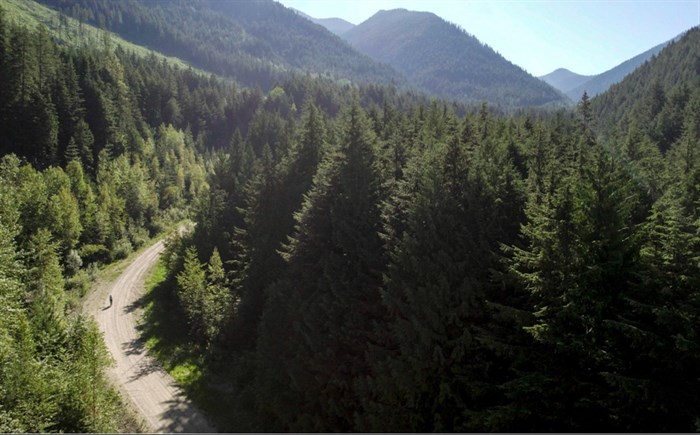
Part of the B.C. Epic 1000 trail from Merritt to Fernie.
Image Credit: Submitted/Bikepacking.com/Blade 9 Films
March 27, 2022 - 7:55 AM
Thousands of people leisurely cycle the Okanagan Rail Trail each year, getting a smooth ride even on road bikes.
Thousands more tour the Myra Canyon along the Kettle Valley Rail Trail trestles high above Kelowna.
But the B.C. Epic 1000 is a beast of a different nature as it travels 600 km on rail beds from Merritt to Castlegar before travelling another 400 km along mostly gravel forestry roads into Fernie.
“Most people think of the KVR (Kettle Valley Railway) as the piece between Penticton and Kelowna because that’s what most people ride, across the trestles and whatnot,” Lennard Pretorius, the creator of the Epic 1000, told iNFOnews.ca. “It would have been nice if the whole thing looked like that. It does not.
“Most of KVR and Columbia and Western rail beds see quite a bit of ATV use in places, and it’s quite dug up and spun up with washboard and loose gravel, and in, other places, it’s overgrown so it’s difficult to follow at some times. In some places they didn’t remove the rail ballast so you’re riding on the road ballast all the time and around Midway and Rock Creek every farmer has a gate that crosses as well.”
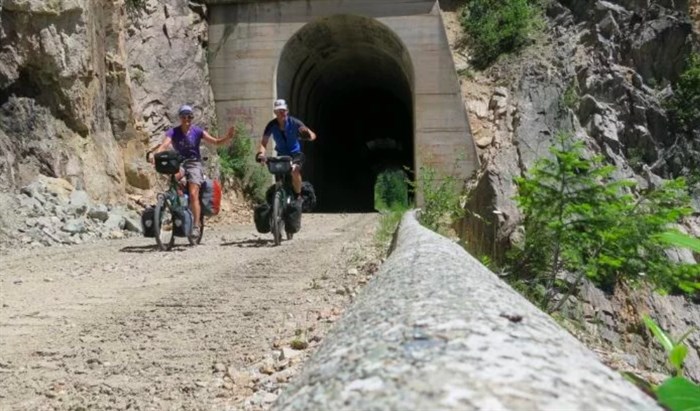
Part of the rail line in the Okanagan.
Image Credit: Submitted/bcEpic1000.com
The gates are not locked but riders have to dismount to open then re-close the gates, all of which takes away precious time for those keen racers trying to complete the route in under three days.
While rail lines are relatively flat, they can still have grades of two to three degrees that seem to go on forever.

Serious cyclists ride through the night.
Image Credit: Submitted/Bikepacking.com/Blade 9 Films
“People think that 600 of 1,000 km is rail grade so that will make it easy but the surface makes up for it in terms of difficulty and just the duration of it,” Pretorius said. “The rail grade climbs, granted not very steeply, but it does so non-stop for 40 or 60 kilometres so it just wears them down over time. Whereas, if you’re on the road, there are steeper pitches but there a flat spots in between.”
It’s actually a relief to reach Castlegar and travel the rest of the way on relatively smooth gravel road.
READ MORE: Major connection along Trail of the Okanagans to open this summer
Pretorius is a Kamloops doctor who created the route in 2015 after he and a friend rode the 600-km Oregon Outback route across that state and realized there was nothing similar back home.
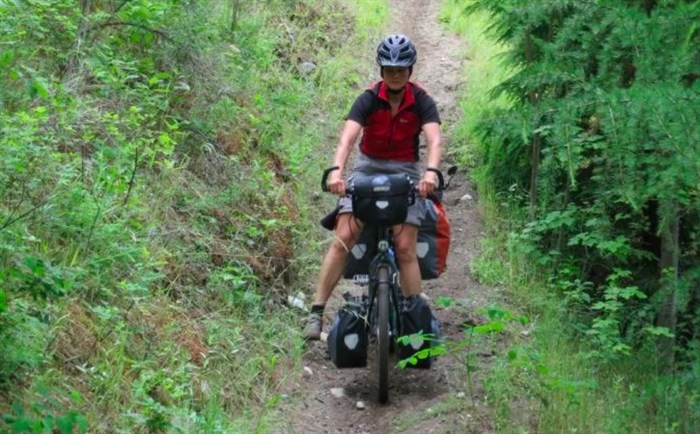
The trail narrows to one track in places.
Image Credit: While rail lines are relatively flat, they can still have grades of two to three degrees that seem to go on forever.
The “grandaddy” of this type of ride is the Great Divide Mountain Bike Route that started about 15 years ago and runs from Banff to Antelope Wells, New Mexico, covering 4,300 km.
The sport is called bikepacking and has only a few specific rules, such as no re-supply stations, no help from, or helping of, others and honesty in time keeping and rule following.
The record for the Great Divide is 13 days, 22 hours and 51 minutes but most are more likely to take six weeks to three months to make the trip along the Continental Divide.
READ MORE: Kamloops, Okanagan cyclists welcome to join this ruelling 6-day tour of Washington State
The route from Merritt to Fernie is a little less daunting and has been completed in less than three days by only four really keen racers, but not Pretorius, who clocked three days, three hours and 47 minutes in 2019 (the race was cancelled in 2020 because of COVID).

Along the KVR.
Image Credit: Submitted/bcEpic1000.com
“My plan was to try and ride the whole thing non-stop, or just ride as far as I could anyway,” Pretorius said. “So, I got to just before Castlegar, which is 600 kms in, and just started literally falling asleep on the bike and falling off. That didn’t work out too well.”
He slept beside the trail for three hours then rode another 25 hours non-stop before falling asleep on his bike and crashing again. He slept another hour.
“I got up and rode another 11 hours to finish, and that still didn’t get me under three days,” he said.
So why push so hard?
“In the heat of the moment and being caught up in the race and you’re sleep deprived, it’s amazing how your judgement deteriorates and you start making stupid decisions,” Pretorius confessed. “I probably won’t attempt that again.”
Tom Hainisch, an American rider, holds the record at two days, 16 hours and 45 minutes, set in 2019 but Kelowna’s Meaghan Hackinen is second overall, making it in two days, 19 hours and 19 minutes last year.
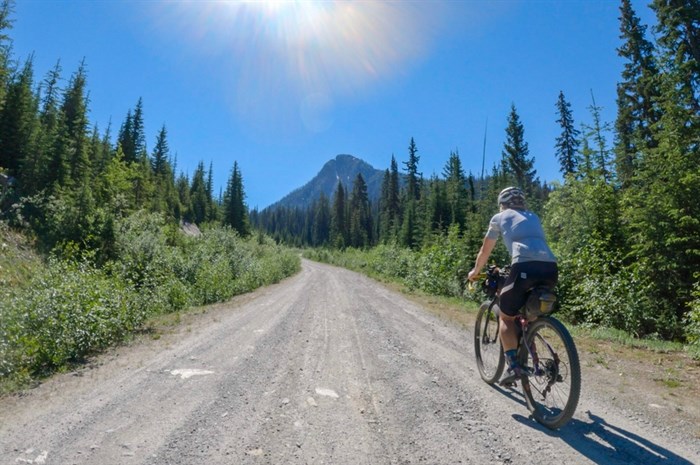
Kelowna's Meaghan Hackinen set the women's record in the middle of the heat dome last year.
Image Credit: Submitted/Bikepacking.com/Blade 9 Films
She did that despite the fact that the Grand Depart was in the middle of B.C.'s heat dome where temperatures soared to 40 Celsius. Only 13 of more than 70 riders who started that day actually finished.
“It was by far the lowest finish rate on account of the heat,” Pretorius said. “Most people, including myself, after the first day or so, decided it wasn’t a good idea to be out there getting cooked like that.”
For many, this is not really a race.
“At the other end of the field are people who just want to experience the route and to ride it and to challenge themselves and to have a good time of it and not ride through the dark and enjoy the scenery and camp every night,” Pretorius said.
That means some take up to 10 days to finish the race in a more leisurely manner. Still, they have to follow the rules.
They keep their own time but the clock never stops, even when they’re sleeping. They must be fully self-sufficient, not sharing food, water or repair kits.
“To complete the route, a rider may resupply food/equipment, rent a room, launder clothing, even service their bike at commercial shops along the way," one rule states. “The intent is to ride unsupported between towns, and function self-supported when in towns. Any services utilized must always be commercially available to all challengers and not pre-arranged. No private resupply, no private lodging.”
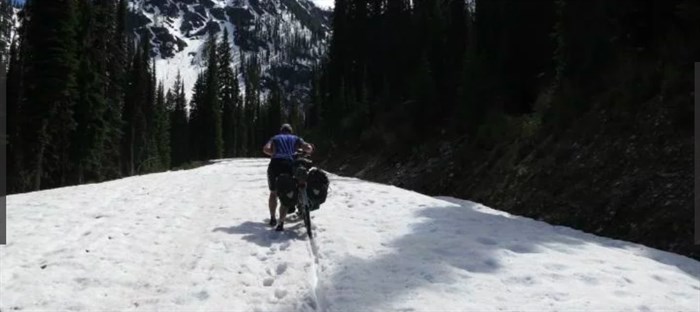
There can be snow at higher elevations, even in late June.
Image Credit: While rail lines are relatively flat, they can still have grades of two to three degrees that seem to go on forever.
On the Great Divide, there can be no visits from friends or family along the way. The rules for the Epic 1000 are a little looser, but not much.
“B.C. Epic feels this is not necessarily a reason to relegate should such an encounter occur as long as no supplies or help of any sort whatsoever is provided to the rider,” the rules say.
The only assistance allowed is in the case of a breakdown where the bike is unrideable. The rider can hitchhike to the nearest repair shop but must return to the exact same spot to resume the tour.
Those who start during the annual Grand Depart qualify in the general classification. Anyone can cover the route at any time but that’s considered an individual time trial because they can select better windows for weather and are better able to make the early morning connection on the Balfour Ferry across Kootenay Lake.
There’s no fee to enter, just register on the B.C. Epic 1000 website, which carries this warning:
“This website is created for informational purposes only. Those of us who ride this and arrange the Depart do not assume any responsibility in any way for any rider who chooses to ride the route at any time. Ensuring your own well being, making sure you are well prepared and awareness of the inherent risks of this undertaking (including injury and death) is entirely your own responsibility.”
The Grand Depart for the 2021 edition of the ride/race is scheduled for 7 a.m. on June 25 at Breathebikes in Merritt.
For more information, go here.
To see the full route, go here:

Image Credit: Submitted/BCEpic1000.com
To contact a reporter for this story, email Rob Munro or call 250-808-0143 or email the editor. You can also submit photos, videos or news tips to the newsroom and be entered to win a monthly prize draw.
We welcome your comments and opinions on our stories but play nice. We won't censor or delete comments unless they contain off-topic statements or links, unnecessary vulgarity, false facts, spam or obviously fake profiles. If you have any concerns about what you see in comments, email the editor in the link above.
News from © iNFOnews, 2022